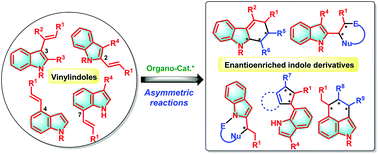Advances in organocatalytic asymmetric reactions of vinylindoles: powerful access to enantioenriched indole derivatives
Abstract
Enantioenriched indole derivatives are widely found in natural products, pharmaceuticals and bioactive compounds. Therefore, developing efficient methods for the synthesis of enantioenriched indole derivatives has become an important goal in the community of organic chemistry. To this end, chemists have designed and developed a variety of indole-containing platform molecules and their related catalytic asymmetric reactions. Among these approaches, vinylindoles have proved to be versatile platform molecules for accessing enantioenriched indole derivatives via catalytic asymmetric reactions, especially organocatalytic asymmetric reactions. Based on this approach, a plethora of chiral indole derivatives have been synthesized with optical purity and structural complexity. This review summarizes advances in vinylindole-based organocatalytic asymmetric reactions since 2008 and includes the applications of some methodologies in the total synthesis of natural products. In addition, this review points out the remaining challenges in this research area to be confronted by organic chemists, which will shed light on the future development of this area.

- This article is part of the themed collection: 2021 Organic Chemistry Frontiers Review-type Articles


 Please wait while we load your content...
Please wait while we load your content...